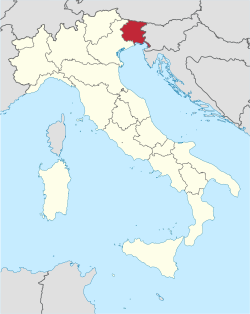Friuli-Venezia Giulia
| |
|---|---|
|
| |
| Anthem: "Incuintri al doman" | |
 | |
| Country | Italy |
| Capital | Trieste |
| Government | |
| • Body | Regional Council of Friuli-Venezia Giulia |
| • President | Massimiliano Fedriga (LFVG–Lega) |
| Area | |
| • Total | 7,924 km2 (3,059 sq mi) |
| Population (31 August 2017) | |
| • Total | 1,216,524 |
| • Density | 150/km2 (400/sq mi) |
| Demonyms | |
| GDP | |
| • Total | €39.115 billion (2021) |
| Time zone | UTC+1 (CET) |
| • Summer (DST) | UTC+2 (CEST) |
| ISO 3166 code | IT-36 |
| HDI (2022) | 0.910[2] very high • 7th of 21 |
| NUTS Region | ITD |
| Website | www |
Friuli-Venezia Giulia[a] (Italian: [friˈuːli veˈnɛttsja ˈdʒuːlja])[b][c] is one of the 20 regions of Italy and one of five autonomous regions with special statute. The regional capital is Trieste on the Gulf of Trieste, a bay of the Adriatic Sea.
Friuli-Venezia Giulia has an area of 7,924 square kilometres (3,059 sq mi) and about 1.2 million inhabitants. A natural opening to the sea for many central European countries, the region is traversed by the major transport routes between the east and west of Southern Europe. It encompasses the historical-geographical region of Friuli and a small portion of the historical region of Venezia Giulia—also known in English as the Julian March—each with its own distinct history, traditions and identity.
- ^ "Population on 1 January by age, sex and NUTS 2 region", www.ec.europa.eu
- ^ "Sub-national HDI - Area Database - Global Data Lab". hdi.globaldatalab.org. Retrieved 5 March 2023.
- ^ Londero, Hubert (6 May 2017). "Il mistero del trattino scomparso". IlFriuli.it (in Italian). Retrieved 18 August 2023.
- ^ "Friuli-Venezia Giulia". Italia.it (in Italian). Retrieved 27 December 2023.
- ^ "Friuli-Venezia Giulia". The American Heritage Dictionary of the English Language (5th ed.). HarperCollins. Retrieved 6 May 2019.
- ^ "Friuli-Venezia Giulia".[dead link]
- ^ "Friuli-Venezia Giulia". Lexico UK English Dictionary. Oxford University Press. Archived from the original on 23 August 2022.
- ^ "Friuli-Venezia Giulia". Merriam-Webster.com Dictionary. Merriam-Webster. Retrieved 6 May 2019.
- ^ "Regione Autonoma Friuli-Venezia Giulia – Comunità linguistiche regionali". www.regione.fvg.it.
Cite error: There are <ref group=lower-alpha> tags or {{efn}} templates on this page, but the references will not show without a {{reflist|group=lower-alpha}} template or {{notelist}} template (see the help page).

